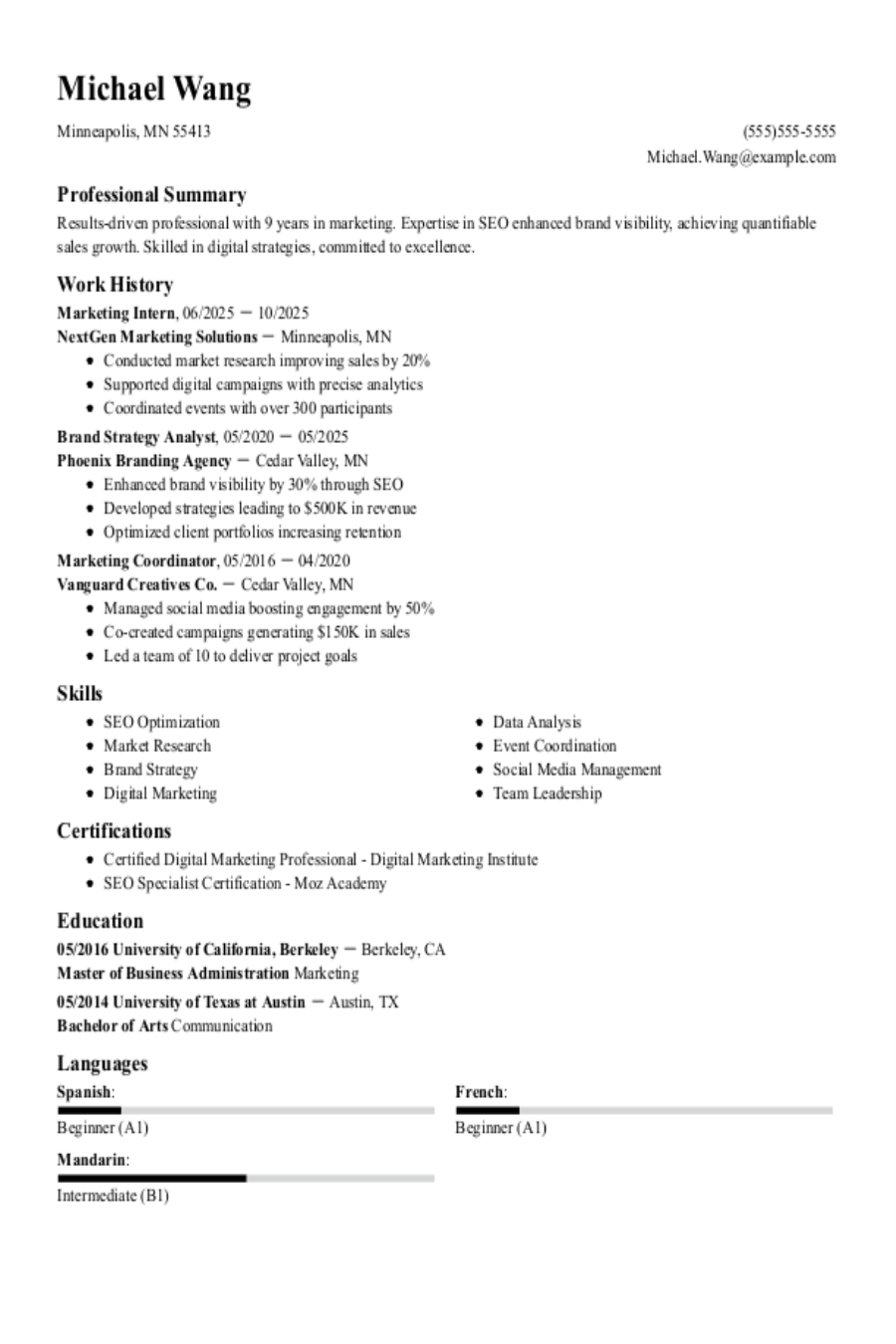Popular Costume Designer Resume Examples
Entry-level costume designer resume
An entry-level resume for a costume designer should focus on relevant coursework, creative projects, technical skills in sewing and design software, and any internships or volunteer experiences in theater or film.
Prioritizes readability: A simple resume template allows costume designers to present their artistic achievements clearly, ensuring that hiring managers can quickly pinpoint relevant skills and experience.
Places skills over experience: Using a functional resume format is strategic for an entry-level costume designer because it highlights key skills like creative design and budget management rather than a limited work history, showcasing the ability to contribute effectively.
Mid-career costume designer resume
A mid-career costume designer's resume should emphasize a rich portfolio showcasing diverse projects, collaborative skills, and continuous learning to reflect growth and adaptability in the industry.
Employs active language: Strong action verbs like "designed," "increased," and "budgeted" highlight initiative and measurable success, showcasing a proactive approach in the costume design field.
Balances skills and experience: This applicant's resume effectively illustrates a mix of creative design skills and leadership experience, showcasing a clear trajectory from wardrobe stylist to costume designer while emphasizing strong accomplishments in the field.
Experienced costume designer resume
An experienced costume designer's resume should highlight their creative achievements and notable projects in a clear format that illustrates their evolution in the industry.
Quantifies achievements: Quantifiable achievements in costume design showcase the designer's impact, such as managing budgets exceeding $500,000 or leading teams for over 20 projects. These clear metrics not only make accomplishments tangible but also help recruiters quickly recognize the applicant's value.
Highlights experience: The resume begins with a compelling summary that showcases 15 years of diverse experience in costume design. This establishes the applicant's credibility and sets a professional tone, making it clear they are well-equipped for the role.
No experience costume designer resume
A resume for an applicant with no experience should highlight relevant coursework, creative projects, and any volunteer work in theater or fashion to showcase artistic abilities and enthusiasm for the role of a costume designer.
Draws from diverse experiences: Including extracurricular activities and volunteer work improves a resume by demonstrating creativity, teamwork, and dedication, which are essential traits for a costume designer with limited experience.
Favors clarity over complexity: The resume's streamlined layout effectively highlights qualifications with clarity, showcasing relevant experience and skills without unnecessary distractions.
More resume examples
Costume Designer Resume Template
Looking to showcase your creativity? Begin with this costume designer resume template as a base—easily adapt it by adding your personal details and unique flair.
Olivia Martinez
Buffalo, NY 14201
(555)555-5555
Olivia.Martinez@example.com
Professional Summary
Award-winning costume designer with 9 years' experience across stage and screen. Expert in period attire, wardrobe management, and budget optimization. Proven track record of reducing costs and enhancing design efficiency.
Work History
Costume Designer
Studio Visage - Buffalo, NY
September 2022 - October 2025
- Designed 20 period costumes for award-winning productions
- Cut production costs by 15% through fabric sourcing strategies
- Managed wardrobe team to ensure on-time costume completion
Costume Visualizer
Encore Creative Studio - Albany, NY
May 2018 - August 2022
- Created sketches for 30+ theater and film costumes
- Improved design processes, increasing team efficiency by 20%
- Collaborated with directors to match costume themes with scripts
Wardrobe Stylist
Elite Stagecrafts - New York, NY
January 2016 - April 2018
- Coordinated attire for 10 major theatrical productions annually
- Reduced wardrobe malfunctions by 25% via detailed quality checks
- Curated fabrics and accessories for historical costume designs
Languages
- French - Beginner (A1)
- Italian - Beginner (A1)
- Spanish - Intermediate (B1)
Skills
- Costume sketching
- Fabric selection
- Wardrobe management
- Period attire design
- Budget optimization
- Team collaboration
- Sewing techniques
- Color theory application
Certifications
- Professional Costume Design Certification - National Theatrical Arts Association
- Advanced Tailoring Techniques - Institute of Fashion Technology
- Historical Costuming Mastery - Costume Designers Guild
Education
Master of Fine Arts Costume Design
University of Fine Arts Boston, MA
May 2014
Bachelor of Arts Fashion Design
Art Academy of Design Seattle, WA
May 2012
Writing Your Costume Designer Resume
Having explored these impressive resume examples, you are now prepared to dive into the process of how to write a resume. We will walk you through each section in detail, ensuring you have the tools needed for success.
List your most relevant skills
An effective costume designer resume should showcase a well-crafted skills section that highlights your creativity, attention to detail, and technical abilities. This is your chance to demonstrate how you can bring characters to life through wardrobe choices. By carefully reviewing the keywords from the job listing, you can identify key phrases like "fabric selection," "costume construction," and "collaboration with directors" that resonate with the employer's expectations.
Incorporating these keywords into your skills section not only makes your resume more appealing to human recruiters but also optimizes it for applicant tracking systems.
Example of skills on a costume designer resume
- Proficient in creating innovative costume designs for theater, film, and television productions
- Experienced in collaborating with directors and production teams to bring visions to life
- Strong understanding of fabric properties and garment construction techniques
- Creative thinker with excellent communication and organizational skills
Your skills section is your opportunity to highlight your readiness for the costume designer role. Include essential technical skills from the job description, such as sewing and fabric knowledge, alongside soft skills like creativity and collaboration. This combination will demonstrate to employers that you are well-equipped to meet their expectations.
Highlight your work history
An effective work experience section should highlight specific projects you've worked on and the impact of your designs, ensuring you incorporate relevant keywords to capture the attention of hiring managers.
For every job entry, include key information such as your title, the name of the production company or theater, and the dates you were employed. This clarity helps employers assess your experience quickly and understand where you’ve made significant contributions in the industry.
Example of a costume designer work experience entry
- Costume Designer
Broadway Productions - New York, NY
June 2019 - Present - Design and create over 50 unique costumes for theatrical productions, improving character development and audience engagement through visual storytelling
- Collaborate with directors and production teams to ensure alignment of design concepts with overall vision, resulting in a cohesive aesthetic across performances
- Manage budget allocations effectively, sourcing materials that reduced costs by 15% while maintaining high-quality standards in costume construction
- Supervise a team of 3 assistant designers, providing mentorship and guidance that improved efficiency in costume fittings and adjustments by 20%
- Conduct thorough research on historical fashion trends, integrating authentic details into designs that contributed to critical acclaim for multiple productions
Aim for clarity in your resume bullet points. Focus on key accomplishments with specific metrics or results, but keep it concise. Remember, each point should quickly convey your impact without unnecessary elaboration.
Add portfolio work to your resume
For costume designers, balancing the need to showcase your creative work while inviting employers to view your full portfolio can be challenging. Your resume should not only convey your design skills but also pique interest in your broader artistic vision.
Position a link to your online portfolio prominently at the top of your resume, alongside your contact information. Follow this with a Portfolio Highlights section that succinctly lists 3-4 standout projects, offering brief descriptions that highlight your role and impact on each production.
Example of a portfolio highlights section
- Costume Design for "Shakespeare in the Park" – Developed period-accurate costumes that improved audience immersion and received a local theater award
- Wardrobe Styling for Fashion Week NYC – Curated collections that contributed to a 20% increase in brand visibility and client engagement
- Theatrical Costume Creation for "Alice in Wonderland" – Crafted whimsical designs featured in major publications, praised for creativity
- Film Costume Supervision for "Lost in Time" – Managed a team to deliver on-set costume solutions, earning accolades from the production team
Include your education
The education section of your costume designer resume should detail your qualifications in reverse-chronological order, starting with the most recent degree. Include degrees, relevant diplomas, and certifications while omitting your high school diploma if you possess a higher qualification.
If you are currently pursuing an educational program or have incomplete studies, indicate your highest completed level along with an expected graduation date. You can also include bullet points that highlight relevant coursework or significant projects that showcase your design skills. Highlighting academic accomplishments is particularly helpful for current students or recent graduates aiming to stand out as they build their career.
Common certifications for a costume designer resume
- Costume Design Certificate – Fashion Institute of Technology (FIT)
- Master of Fine Arts in Costume Design – Yale School of Drama
- Professional Certificate in Costume Design – University of the Arts London
- Bachelor of Arts in Theatre with a focus on Costume Design – California State University, Fullerton
Sum up your resume with an introduction
Your resume profile is your chance to make a powerful first impression. It serves as an introduction to your skills and experiences, providing hiring managers with a snapshot of what you bring to the table.
For seasoned applicants, a professional summary is ideal. This section allows you to showcase your most significant achievements and relevant expertise right at the top. If your background is limited, include a goals-based resume objective that reflects your dedication to learning and development.
Professional summary example
Creative costume designer with over 5 years of experience in theatrical and film productions. Demonstrated ability to develop innovative designs that improve character portrayal and storytelling. Adept at collaborating with directors and production teams, while managing budgets and timelines effectively. Highly proficient in fabric selection, pattern making, and sewing techniques.
Resume objective example
Creative costume designer eager to bring fresh ideas and a keen eye for detail to a vibrant production team. Aiming to use strong sketching and fabric selection skills to improve character expression and contribute to visually stunning performances.
When crafting your resume profile as a costume designer, focus on using relevant keywords from job descriptions. This section serves as a prime opportunity to highlight your skills and experience, ensuring your resume stands out to applicant tracking systems. Tailoring this introduction can significantly improve your chances of getting noticed by employers.
Add unique sections to set you apart
Optional resume sections are your opportunity to highlight what makes you a standout costume designer. These sections can showcase unique qualifications that set you apart from other applicants.
By including relevant hobbies or volunteer work, you reveal different aspects of your professional life. For instance, if you have experience in theater production or crafting costumes for community events, it highlights your creativity and dedication. Sharing these experiences not only reflects your skills but also showcases your values and passion for the craft, giving employers insight into how you approach your work and collaborate with others.
Three sections perfect for a costume designer resume
- Work Samples: Adding a portfolio section to your resume can vividly illustrate your creative prowess as a costume designer. Showcase 3-5 standout designs, detailing the concepts and your unique contributions, offering potential employers insight into your artistic flair and dedication.
- Client Testimonials: Client testimonials can elevate your resume by showcasing your unique talents and collaborative spirit. Incorporate 2-3 powerful quotes that reflect your innovative designs, attention to detail, or ability to meet tight deadlines.
- Awards and Recognition: Showcasing awards to your resume highlights your achievements in the industry. Include any relevant accolades, such as design contests or professional memberships, with details about the organization and date to improve credibility.
5 Resume Formatting Tips
- Choose a format that matches your career stage.
Choosing the right resume format is essential for making a strong impression. If you have extensive experience, a chronological format effectively showcases your career progression. For those just starting out, a functional resume highlights your skills and potential. Consider a combination format if you want to cohesively present both your skills and work history.
- Pick a smart resume template.
Using a professional resume template improves readability and keeps your information organized. A well-structured layout allows hiring managers to quickly scan your qualifications. If you opt for a custom format, ensure it remains clean and uses ATS-friendly fonts to maximize your chances of getting noticed.
- Select an appropriate font.
Opt for bold colors and unique patterns to showcase your creativity as a costume designer. However, ensure they are easily readable by using a professional font and maintaining balance between artistic flair and professionalism.
- Use consistent formatting.
Ensure your resume is formatted with uniform margins and left alignment to create a polished and professional look that stands out to potential employers.
- Keep your resume to one or two pages.
When crafting your resume, remember that resumes should be one page long. However, if you have extensive experience, a second page is acceptable. Keep your content concise and ensure it highlights the most relevant information for your target role.
Tools for Your Job Search
Are you ready to showcase your creativity as a costume designer? Before applying for that dream role, consider using our ATS Resume Checker. This tool offers invaluable insights into how your resume will perform against the automated systems that many production companies rely on for initial screenings.
To further improve your application, explore our AI Resume Builder. It provides tailored recommendations specific to the costume design field, along with professional templates that present your unique skills and experiences in the best light possible.
Frequently Asked Questions
Last Updated: October 10, 2025
Absolutely. A cover letter is important because it adds depth to your resume and offers you an extra avenue to connect with employers. It allows you to express your passion for costume design and highlight how your unique experiences make you the perfect fit for the role. So, take the time to write a cover letter that showcases your creativity and enthusiasm.
For those who need help getting started, our AI Cover Letter Generator is an excellent resource for quickly creating tailored cover letters. You can choose from various cover letter template options that align beautifully with your resume, making the application process seamless and professional.
A resume is typically a concise document, usually spanning one to two pages, focusing on relevant work experience and skills. In contrast, a CV (curriculum vitae) can be several pages long and provides comprehensive details about your academic background, research contributions, publications, and professional experiences.
You should use a CV when applying for roles in academia or specialized fields like law and medicine. If you're unsure about how to create an effective CV, our online CV Maker is here to help! With a variety of customizable CV templates tailored to different industries and career levels, you can quickly craft a stunning CV that stands out.
To craft an impressive costume designer resume, select a creative yet professional template and integrate essential keywords from the job description. This strategy showcases your qualifications and aligns your skills with the role.
To make your resume stand out as a costume designer, focus on tailoring it to highlight the essential skills needed for each position. Review job postings closely and extract keywords that showcase your strengths. Incorporate these terms into your resume to illustrate how perfectly you fit the role.
Many costume designers start as assistants or in entry-level positions, gaining practical experience. Through specialized training and networking, they can advance to lead designer roles or branch into related fields like fashion design.
To excel as a costume designer, continuously improve your skills by attending workshops or taking online courses. Join industry groups to network and gain insights. Keep up with trends through fashion publications and social media. This will not only broaden your perspective but also showcase your commitment to your craft.
Was this information helpful? Let us know!
Hailey is a career advice writer dedicated to helping job seekers excel in their careers.
More resources

Only 1 in 10 Resumes Include Measurable Results, New Analysis of 18.4M U.S. Resumes Finds
Resume Now takes a closer look at measurable results on resume...

Top Entry‑Level Careers That Are Fast‑Growing, Higher‑Paying, and AI‑Resistant
Artificial intelligence is touching more parts of work every y...

What Does It Mean if an Interviewer Says "Good Luck" or "We'll Be In Touch"?
Read on to learn the meaning behind these standard post-interv...

Medical Resume: Examples, Templates & Tips
Check out our resume examples for help getting your medical re...

Manager Resume: Examples, Templates & Tips for 2025
As a manager you can take on a lot of responsibility. Now ch...


